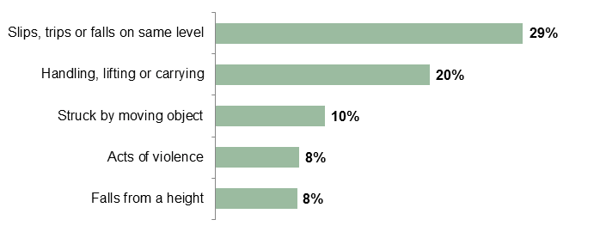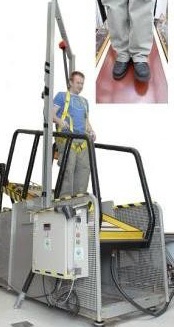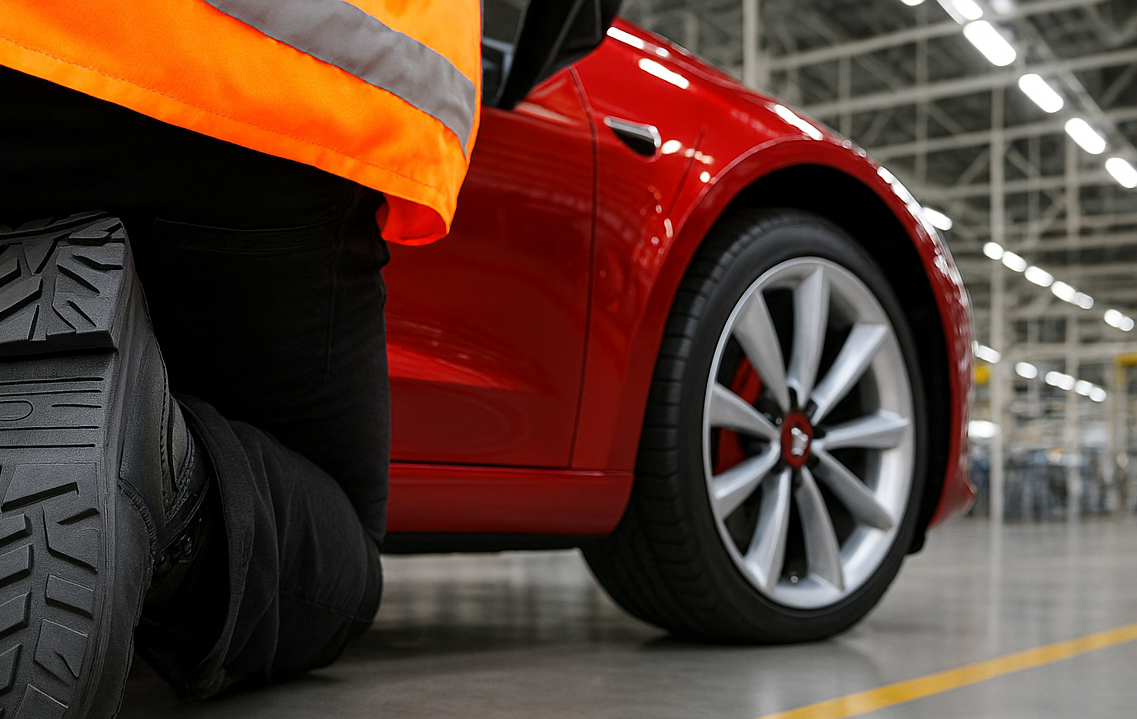Slips and trips are still the biggest workplace danger, causing serious injury and even leading to fatalities. The cost to business and lives is immeasurable, but can often be avoided with low-cost measures in place. Charlie Turner looks at how to reduce the slip and trip risk.
WE CAN’T ESCAPE THE FACTS
You don’t have to do much research to stumble across some shocking figures that show the contribution slips, trips and falls have on fatal and non-fatal workplace injuries. Sadly, many employers don't give slips and trips the priority they deserve, treating them as being outside their control, inevitable or simply the employee’s fault. Often the measures needed are simple and low-cost, but they will bring about significant reductions in both human suffering and costs. It also comes as no surprise that the Health and Safety Executive (HSE) have been doing some great work raising awareness for the past few years with their ‘shattered lives’ campaign.
Source: https://www.hse.gov.uk/statistics/causinj/index.htm
Slipping and tripping are the most common causes of major injuries within UK workplaces. The latest information on non-fatal injuries reported under RIDDOR for 2020/2021 shows a massive 33% of all workplace injuries are as a result of slips, trips and falls. 95% of these accidents involve broken bones and 27% of slips trips and falls resulted in over seven days of absence from work. HSE statistics also reveal that 75% of self-reported incidents resulted in absences of up to seven days, which means employees are annually on leave for 130,000 days.
Slips and trips are often the initiators of accidents attributed to other causes, such as some machinery accidents, scalding and an estimated one-third of falls from height. Falls from height are the cause of 25% of fatal injuries and in 2021/2022 resulted in 35 fatalities. The human cost isn't something you can put a figure on, but in pounds and pence, they cost UK businesses over £500 million a year!
It is all very well looking at country-wide data, but how does this relate to my company or my industry? Below is a list of industries in risk order (highest risk at the top) from the HSE 2009/2010 data showing slips, trips and falls per 100,000 employees:-
- Recycling
- Sewage & refuse disposal
- Land transport
- Post and telecoms
- Supply of water
- Food & beverage manufacturing
- Other mining and quarrying
- Water transport
- Air transport
- Construction
WHAT CAN YOU DO?
For slip and trip risks to be adequately controlled, you need to undertake a risk assessment. There is a hierarchy of slip controls:
- Contamination
- Flooring
- Cleaning
- Footwear
Firstly, it is important to try and prevent contamination getting on the floor to remove anything coming between the wearer’s foot and the floor surface. Consider this analogy: when you get water on the road, the car is highly susceptible to aquaplaning - and footwear is no exception. The sole needs to make contact with the floor to get any grip.
Secondly, although usually one of the most financially costly, assess the floor surface and look at ways to improve the surface grip. To understand the level of slip resistance your current floor provides, you are able to get a co-efficient of friction (CoF) test. A number of companies provide this as a service and they use something called the pendulum test to give you a Pendulum Floor Test (PTV) value.
Third on the list is cleaning. Well planned cleaning regimes will not only have an effect on flooring appearance and hygiene, but should also reduce the likelihood of slip accidents. When selecting an effective cleaning programme, speak to flooring manufacturers and cleaning equipment suppliers who can provide advice on cleaning methods for your floor, then decide when to clean - out of hours for example.
Highly slip resistant footwear is often one of the most overlooked, lower cost and effective ways of reducing slips.
Fourth and finally my passion - footwear (no surprises there!). Highly slip-resistant footwear is often one of the most overlooked, low costing and effective ways of reducing slips. I once went on an advanced driving course and the instructor (who happened to be ex-police) said ‘never save on your tyres’ - because they are your only contact with the road. Similarly, footwear is your only contact with the ground and highlights the importance of good slip-resistant footwear. Footwear will also be the only constant in measuring slips, as often production facilities need to have different floor surfaces. There are also other far-reaching impacts that footwear can have on staff welfare if they are well fitted, cushioned and supportive.
We have created a slip safety online test where you can benchmark how at risk your company is of slips trips and falls. You will also receive a report once completed highlighting the actions you can take to reduce your slip risk today.
WHEN THE HIERARCHY slips up
A couple of year ago I posted a survey on LinkedIn, specifically requesting feedback from people in Health and Safety roles on what they would look at first to reduce slips. Almost without exception they responded with flooring! Now, I don’t disagree with that, however there are often occasions when this is not the right answer.
A large part of the UK workforce work in locations and on surfaces they cannot control or influence. For example, someone working in the Facilities Management sector has no control over the floor surface of the property they are entering - and if working outside, they can’t influence the weather. In many cases they also have little to no control over the cleaning programme and this is when the hierarchy slips up. If you cannot control or influence each part of the hierarchy of control then the priorities change, and in the case of facilities management, footwear becomes THE most important factor in reducing slips. This also applies to people employed in refuse collection, as they cannot influence the surface they need to walk on to access the refuse bins. This sounds simple, but is all too often a revelation when explained to people.
CHOOSING THE RIGHT GRIP
When choosing footwear, do not rely solely on marketing claims for 'slip resistance' or the published SRA, SRB or SRC European slip ratings. Although these are a good guide to the level of slip resistance, there are a number of other factors to consider. The slip rating guide below describes the test method used to asses slip resistance:-

So, the first important point - it is very rare for a large percentage of the UK workplaces to have either tiled floors with water on them, and I certainly don’t know many that have steel floors with oil on. Secondly, you need to consider clogging. If people are working where contamination is on the floor or the surface is loose (i.e. mud) then often an SRC performing sole with a close tread pattern will become clogged and its slip performance vastly reduced.
Sole technology is actually very closely aligned to tyre technology. It is important you choose your sole/tyre with the surface in mind. Usually a tight sole pattern with lots of channels will work well on a smooth man made floor surface as it effectively channels liquid away and has maximum surface contact like your car tyre. On the flip side, a sole with larger, chunky lugs with more open channels will grip better on natural and loose surfaces such as mud and ballast - like a tractor tyre.

Additionally, you can check if there is any other testing on the sole unit. The HSE have developed a test called the ‘GRIP’ scheme which simulates a walking cycle where footwear can achieve a star rating. Some manufacturers have tested footwear on industry surfaces like scaffold board and Kennedy grating.
As well as the grip pattern, it is important to assess how the sole would provide grip on ladders or steps where the surface area of contact is small. Highlighted in the data in the first section of this article, ladders and falls from height are a great risk. We now live in an age where ladder training, anchoring the ladders, harnesses and good ladders are now a regularly used. If the shoes have little or no heel breast and the profile is flat like a trainer sole, the risk of slipping off or through the rungs is very high, especially when contaminated with mud or water. When looking for footwear that will be used on ladders, check if they have any specific standards (as there is a ladder grip standard) or check if the heel is a minimum of 10mm. Find out more about good ladder safety in our blog here.
Balancing wear with grip is really important as again with tyres, a sports track tyre would only last a few laps due to the soft density to give the car maximum grip. But if the tyre is too hard, it will have a lower grip rating. Wear trials are important here to assess how long the product lasts and check manufacturers' warranties, giving you confidence in a cost effective and lasting solution.
Safety standards are changing – and it’s affected slip testing and codes.
The slip resistance markings of SRA, SRB and SRC will no longer exist in the updated EN ISO 20345:2022 footwear safety standards. Slip testing will not carry a mark as slip safety is considered such an essential part of safety. A manufacturer can specify an additional slip test, which if the boot passes can be awarded an SR code.
Read here to see how these updates could affect you and your company.
WHY TRIAL?
I can’t word it better than the HSE when it comes to this point:
“The HSE recommends that you consider asking your supplier to provide trial pairs to help you make the right choice, and do not select footwear on the basis of brochure descriptions or laboratory test results alone.”
Trialling footwear not only ensures you are providing the correct footwear for your workforce, but it also helps get their buy-in, as often it can be assumed a footwear change is to save costs rather than improve safety. The footwear is tested in real environments and not only the slip resistance, but comfort and user experience can be identified here. This is very important, as you can have the most slip resistant boot - but if it is not comfortable, compliance will become a challenge, as people will purchase their own or just not wear it. Documenting the trial process will also help give substantiating evidence on footwear selection if anyone is ever unfortunate enough to have a slip accident in the workplace.






